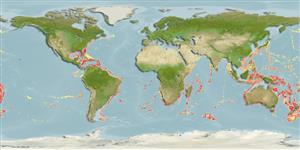>
Acropomatiformes (Oceanic basses) >
Epigonidae (Deepwater cardinalfishes)
Etymology: Epigonus: Greek, epi = over, in front + Greek, gonio = angle (Ref. 45335); macrops: Named for Godfrey Merlen, a Galápagos naturalist (Ref. 13749).
Environment: milieu / climate zone / depth range / distribution range
Ekologi
laut; payau batidemersal; kisaran kedalaman 550 - 1300 m (Ref. 31632). Deep-water
Indo-Pacific: Tanzania to Viet Nam (Ref. 31632), Indonesia (Ref. 26165) and western Australia. Western Atlantic: Florida, USA (Ref. 31632) to Suriname and French Guiana (Ref. 13608).
Size / Weight / umur
Maturity: Lm ? range ? - ? cm
Max length : 21.2 cm SL jantan/; (Ref. 26165)
No opercular spines. 8 spines on first dorsal fin. Pyloric caeca 7-8 (light organ present in one of the caeca). Premaxillary teeth elongated, thin, remain visible when mouth closed (Ref. 31632).
A mesobenthic-pelagic species living mainly above the bottom (Ref. 31632). Found on the continental slope (Ref. 7300).
Life cycle and mating behavior
Kematangan | Reproduksi, perkembang biakan | Pemijahan | telur-telur | Fecundity | Larva
Paxton, J.R., D.F. Hoese, G.R. Allen and J.E. Hanley, 1989. Pisces. Petromyzontidae to Carangidae. Zoological Catalogue of Australia, Vol. 7. Australian Government Publishing Service, Canberra, 665 p. (Ref. 7300)
Status IUCN Red List (Ref. 130435)
ancaman kepada manusia
Harmless
penggunaan manusia
informasi lanjut
Nama-nama umumSinonim (persamaan)metabolismePemangsaEkotoksikologiReproduksi, perkembang biakanKematanganPemijahanSpawning aggregationFecunditytelur-telurpekembangan telor
AcuanBudidaya airprofil budidaya airStrainGenetikaElectrophoresesDiturunkanPenyakit-penyakitPengolahanNutrientsMass conversion
mitraGambarStamps, Coins Misc.Suara-suaraCiguateraKecepatanTipe renangArea insangOtolithsOtakPenglihatan / visi
Alat, peralatan
laporan khas
muat turun XML
Sumber internet
Estimates based on models
Preferred temperature (Ref.
123201): 2.9 - 9.6, mean 6.3 °C (based on 555 cells).
Phylogenetic diversity index (Ref.
82804): PD
50 = 0.5000 [Uniqueness, from 0.5 = low to 2.0 = high].
Bayesian length-weight: a=0.00646 (0.00278 - 0.01501), b=3.09 (2.88 - 3.30), in cm total length, based on LWR estimates for this (Sub)family-body shape (Ref.
93245).
Trophic level (Ref.
69278): 3.5 ±0.5 se; based on size and trophs of closest relatives
Daya lenting (Ref.
120179): sedang, Waktu penggandaan populasi minimum 1.4 - 4.4 tahun (Preliminary K or Fecundity.).
Fishing Vulnerability (Ref.
59153): Low vulnerability (16 of 100).
